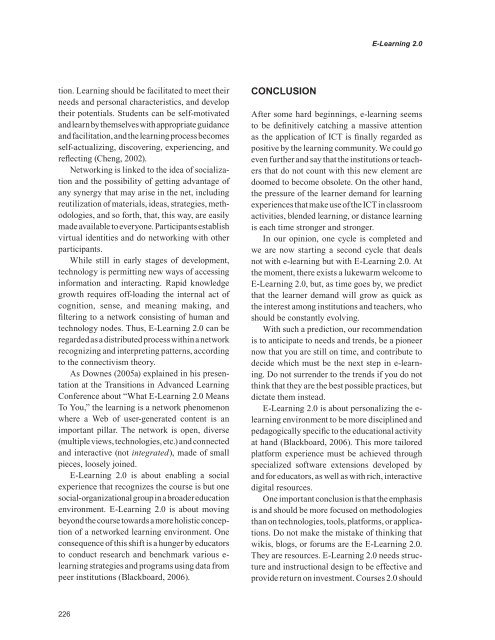Advances in E-learning-Experiences and Methodologies
Create successful ePaper yourself
Turn your PDF publications into a flip-book with our unique Google optimized e-Paper software.
E-Learn<strong>in</strong>g 2.0<br />
tion. Learn<strong>in</strong>g should be facilitated to meet their<br />
needs <strong>and</strong> personal characteristics, <strong>and</strong> develop<br />
their potentials. Students can be self-motivated<br />
<strong>and</strong> learn by themselves with appropriate guidance<br />
<strong>and</strong> facilitation, <strong>and</strong> the learn<strong>in</strong>g process becomes<br />
self-actualiz<strong>in</strong>g, discover<strong>in</strong>g, experienc<strong>in</strong>g, <strong>and</strong><br />
reflect<strong>in</strong>g (Cheng, 2002).<br />
Network<strong>in</strong>g is l<strong>in</strong>ked to the idea of socialization<br />
<strong>and</strong> the possibility of gett<strong>in</strong>g advantage of<br />
any synergy that may arise <strong>in</strong> the net, <strong>in</strong>clud<strong>in</strong>g<br />
reutilization of materials, ideas, strategies, methodologies,<br />
<strong>and</strong> so forth, that, this way, are easily<br />
made available to everyone. Participants establish<br />
virtual identities <strong>and</strong> do network<strong>in</strong>g with other<br />
participants.<br />
While still <strong>in</strong> early stages of development,<br />
technology is permitt<strong>in</strong>g new ways of access<strong>in</strong>g<br />
<strong>in</strong>formation <strong>and</strong> <strong>in</strong>teract<strong>in</strong>g. Rapid knowledge<br />
growth requires off-load<strong>in</strong>g the <strong>in</strong>ternal act of<br />
cognition, sense, <strong>and</strong> mean<strong>in</strong>g mak<strong>in</strong>g, <strong>and</strong><br />
filter<strong>in</strong>g to a network consist<strong>in</strong>g of human <strong>and</strong><br />
technology nodes. Thus, E-Learn<strong>in</strong>g 2.0 can be<br />
regarded as a distributed process with<strong>in</strong> a network<br />
recogniz<strong>in</strong>g <strong>and</strong> <strong>in</strong>terpret<strong>in</strong>g patterns, accord<strong>in</strong>g<br />
to the connectivism theory.<br />
As Downes (2005a) expla<strong>in</strong>ed <strong>in</strong> his presentation<br />
at the Transitions <strong>in</strong> Advanced Learn<strong>in</strong>g<br />
Conference about “What E-Learn<strong>in</strong>g 2.0 Means<br />
To You,” the learn<strong>in</strong>g is a network phenomenon<br />
where a Web of user-generated content is an<br />
important pillar. The network is open, diverse<br />
(multiple views, technologies, etc.) <strong>and</strong> connected<br />
<strong>and</strong> <strong>in</strong>teractive (not <strong>in</strong>tegrated), made of small<br />
pieces, loosely jo<strong>in</strong>ed.<br />
E-Learn<strong>in</strong>g 2.0 is about enabl<strong>in</strong>g a social<br />
experience that recognizes the course is but one<br />
social-organizational group <strong>in</strong> a broader education<br />
environment. E-Learn<strong>in</strong>g 2.0 is about mov<strong>in</strong>g<br />
beyond the course towards a more holistic conception<br />
of a networked learn<strong>in</strong>g environment. One<br />
consequence of this shift is a hunger by educators<br />
to conduct research <strong>and</strong> benchmark various e-<br />
learn<strong>in</strong>g strategies <strong>and</strong> programs us<strong>in</strong>g data from<br />
peer <strong>in</strong>stitutions (Blackboard, 2006).<br />
concLusIon<br />
After some hard beg<strong>in</strong>n<strong>in</strong>gs, e-learn<strong>in</strong>g seems<br />
to be def<strong>in</strong>itively catch<strong>in</strong>g a massive attention<br />
as the application of ICT is f<strong>in</strong>ally regarded as<br />
positive by the learn<strong>in</strong>g community. We could go<br />
even further <strong>and</strong> say that the <strong>in</strong>stitutions or teachers<br />
that do not count with this new element are<br />
doomed to become obsolete. On the other h<strong>and</strong>,<br />
the pressure of the learner dem<strong>and</strong> for learn<strong>in</strong>g<br />
experiences that make use of the ICT <strong>in</strong> classroom<br />
activities, blended learn<strong>in</strong>g, or distance learn<strong>in</strong>g<br />
is each time stronger <strong>and</strong> stronger.<br />
In our op<strong>in</strong>ion, one cycle is completed <strong>and</strong><br />
we are now start<strong>in</strong>g a second cycle that deals<br />
not with e-learn<strong>in</strong>g but with E-Learn<strong>in</strong>g 2.0. At<br />
the moment, there exists a lukewarm welcome to<br />
E-Learn<strong>in</strong>g 2.0, but, as time goes by, we predict<br />
that the learner dem<strong>and</strong> will grow as quick as<br />
the <strong>in</strong>terest among <strong>in</strong>stitutions <strong>and</strong> teachers, who<br />
should be constantly evolv<strong>in</strong>g.<br />
With such a prediction, our recommendation<br />
is to anticipate to needs <strong>and</strong> trends, be a pioneer<br />
now that you are still on time, <strong>and</strong> contribute to<br />
decide which must be the next step <strong>in</strong> e-learn<strong>in</strong>g.<br />
Do not surrender to the trends if you do not<br />
th<strong>in</strong>k that they are the best possible practices, but<br />
dictate them <strong>in</strong>stead.<br />
E-Learn<strong>in</strong>g 2.0 is about personaliz<strong>in</strong>g the e-<br />
learn<strong>in</strong>g environment to be more discipl<strong>in</strong>ed <strong>and</strong><br />
pedagogically specific to the educational activity<br />
at h<strong>and</strong> (Blackboard, 2006). This more tailored<br />
platform experience must be achieved through<br />
specialized software extensions developed by<br />
<strong>and</strong> for educators, as well as with rich, <strong>in</strong>teractive<br />
digital resources.<br />
One important conclusion is that the emphasis<br />
is <strong>and</strong> should be more focused on methodologies<br />
than on technologies, tools, platforms, or applications.<br />
Do not make the mistake of th<strong>in</strong>k<strong>in</strong>g that<br />
wikis, blogs, or forums are the E-Learn<strong>in</strong>g 2.0.<br />
They are resources. E-Learn<strong>in</strong>g 2.0 needs structure<br />
<strong>and</strong> <strong>in</strong>structional design to be effective <strong>and</strong><br />
provide return on <strong>in</strong>vestment. Courses 2.0 should


